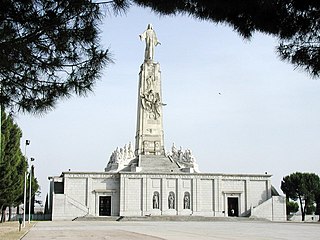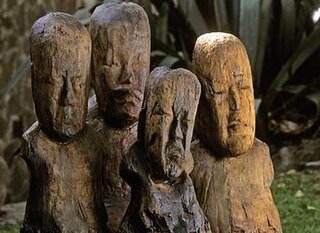
San Salvador is the capital and the largest city of El Salvador and its eponymous department. It is the country's political, cultural, educational and financial center. The Metropolitan Area of San Salvador, which comprises the capital itself and 13 of its municipalities, has a population of 2,404,097. The urban area of San Salvador has a population of 1,600,000 inhabitants.

Christ the Redeemer is an Art Deco statue of Jesus Christ in Rio de Janeiro, Brazil, created by French sculptor Paul Landowski and built by Brazilian engineer Heitor da Silva Costa, in collaboration with French engineer Albert Caquot. Romanian sculptor Gheorghe Leonida sculpted the face. Constructed between 1922 and 1931, the statue is 30 metres (98 ft) high, excluding its 8-metre (26 ft) pedestal. The arms stretch 28 metres (92 ft) wide. It is made of reinforced concrete and soapstone. Christ the Redeemer differs considerably from its original design, as the initial plan was a large Christ with a globe in one hand and a cross in the other. Although the project organisers originally accepted the design, it later changed to the statue of today, with the arms spread out wide.

The Great Pyramid of Cholula, also known as Tlachihualtepetl, is a complex located in Cholula, Puebla, Mexico. It is the largest archaeological site of a pyramid (temple) in the New World, as well as the largest pyramid by volume known to exist in the world today. The adobe brick pyramid stands 25 metres (82 ft) above the surrounding plain, which is significantly shorter than the Great Pyramid of Giza's height of 146.6 metres (481 ft), but much wider, measuring 300 by 315 metres in its final form, compared to the Great Pyramid's base dimensions of 230.3 by 230.3 metres. The pyramid is a temple that traditionally has been viewed as having been dedicated to the god Quetzalcoatl. The architectural style of the building was linked closely to that of Teotihuacan in the Valley of Mexico, although influence from the Gulf Coast is evident as well, especially from El Tajín.

The Cerro de los Ángeles is a hill located in Getafe, Spain, about 10 km (6.2 mi) south of Madrid. The site is famous for being the geographic centre of the Iberian Peninsula. On top of the hill there is a fourteenth-century monastery named Our Lady of the Angels, as well as the Monument to the Sacred Heart of Jesus, built in 1919 to dedicate the country and inaugurated by king Alfonso XIII.

Cristo Rey is a statue on top of Cerro del Cubilete,, a 200 metres (660 ft) mountain in Silao Municipality in Guanajuato, Mexico.

Choquequirao is an Incan site in southern Peru, similar in structure and architecture to Machu Picchu. The ruins are buildings and terraces at levels above and below Sunch'u Pata, the truncated hill top. The hilltop was anciently leveled and ringed with stones to create a 30 by 50 m platform.

El Manatí is an archaeological site located approximately 60 km south of Coatzacoalcos, in the municipality of Hidalgotitlán 27 kilometers southeast of Minatitlán in the Mexican state of Veracruz. El Manatí was the site of a sacred Olmec sacrificial bog from roughly 1600 BCE until 1200 BCE.

El Cristo de las Noas, located on the Cerro de las Noas hill, in the Mexican city of Torreón, Coahuila, is a large sculpture by Vladimir Alvarado, portraying Jesus Christ. It was built between 1973 and 2000.

Cerro Sechín is an archaeological site in Casma Province of Ancash Region in northern Peru. Dating to 1600 BC, the site was discovered by Peruvian archaeologists Julio C. Tello and Toribio Mejía Xesspe on July 1, 1937. Tello believed it was the capital of an entire culture, now known as the Casma/Sechin culture or Sechin complex. Notable features include megalithic architecture with carved figures in bas-relief, which graphically dramatize human sacrifices. Cerro Sechín is situated within the Sechin Alto Complex, as are Sechin Bajo, and Taukachi-Konkan. There is a small on-site museum. The slabs at Cerro Sechin may represent the central Andes' oldest known monumental sculpture.

Monserrate is a high mountain over 10,000 feet high that dominates the city center of Bogotá, the capital city of Colombia. It rises to 3,152 meters (10,341 ft) above the sea level, where there is a church with a shrine, devoted to El Señor Caído.

Cerro de la Minas is an archaeological site located in the modern state of Oaxaca, just to the north of the city of Huajuapan de León. The site belongs to what is called the Ñuiñe, or lowland/hot lands Mixtec cultural area. The site is located on a hill that dominates the Valley of Huajuapan, in what are now the neighborhoods of Chapultepec, Santa Rosa, Alta Vista and Del Maestro of the city. This large hill is in a strategic position over the farmlands of the valley, which provided it with its food, as well as the trade routes that cross this valley, which made it regionally important. The site contains a number of settlements and was reserved for the elite of that area during that time. Cerro de las Minas is the only lowland Mixtec archeological site open to the public.
Barajas is an archaeological site located in the municipality of Pénjamo, Guanajuato, Mexico, which includes a large complex of approximately 15 archeological sites in good preservation state, built on a small volcanic massif in the Bajío,

Altavista, or Chalchihuites, is an archaeological site near the municipality of Chalchihuites in the Mexican state of Zacatecas, in the northwest of Mexico. It is believed that the site was a cultural oasis that was occupied more or less continuously from AD 100 to AD 1400.

El Cerrito is an archaeological zone in the central Mexican state of Querétaro. It is located in the municipality of Corregidora on the outskirts of the state capital, Santiago de Querétaro.

The Cristo del Otero is a large sculpture and symbol of the city of Palencia in Spain, located on a knoll (otero) on the outskirts of the city. Another name, much less popular, is the Monument to the Sacred Heart of Jesus. The sculpture was designed by Victorio Macho, and it is also the location of his tomb.

The Monument to Cuauhtémoc is an 1887 monument dedicated to the last Mexica ruler (tlatoani) of Tenochtitlan Cuauhtémoc, located at the intersection of Avenida de los Insurgentes and Paseo de la Reforma in Mexico City. It is the work of Francisco Jiménez and Miguel Noreña in the "neoindigenismo", and was proposed to promote the new government of Porfirio Díaz.
















